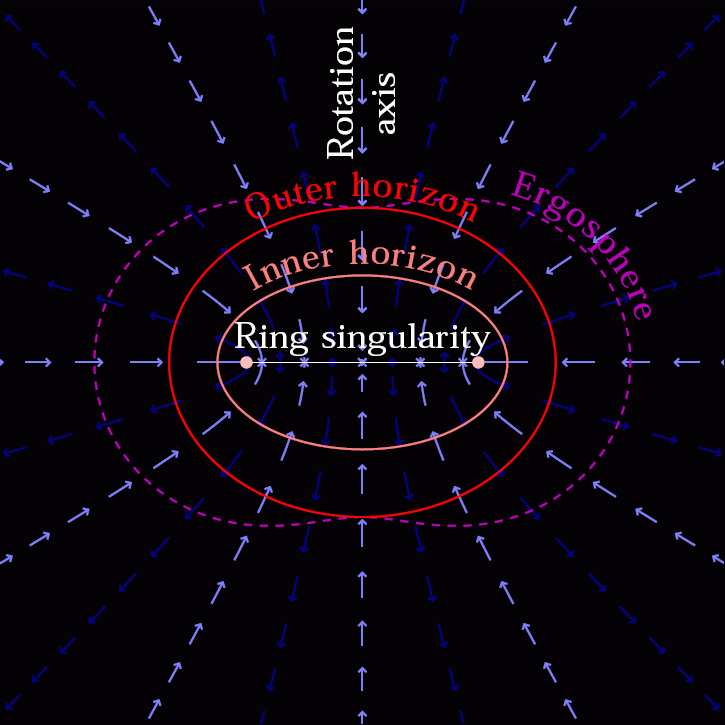Traversible Worm Holes and Time Travel
See G.H. George 1990, Journal Royal Astronomical Society of
Canada, 84, 28,
Inside Black Holes
for more detailed remarks on solutions to Einstein's Equations.
Static Black Holes: Schwarzschild Metric
Static Black Holes are spherical in shape.
The Event Horizon marks the outer edge of the black hole. The
Event Horizon is the radius inside of which the escape speed from
the Black Hole is greater than the speed of light c.
Once objects cross the Event Horizon, they are cut-off
from our Universe and inexorably fall into the center of the Black Hole,
the singularity. |

|
Rotating Black Holes: Kerr Metric
A spinning black hole drags spacetime around in its vicinity (Frame
Dragging). The outer surface marking the ergosphere, is the static
limit as objects cannot be stationary within the
ergosphere. Inside the ergosphere sits the Event Horizon.
As normal, once objects cross the Event Horizon, they are cut-off
from our Universe. |

|
In a static black hole, the Event Horizon has radius,
Rs=2GM/c2 = 3 km (M/Ms),
the Schwarzshild Radius. Once inside the event horizon,
one is cut-off from the outside Universe. After
crossing the event horizon,
space and time change character in the sense that
one must flow spatially into the singularity, and one has a limited
freedom for movement in time. In a Kerr metric, there are two critical
surfaces given by the - and + signs of
R = 0.5 Rs[1-+(1-(lc/GMm)2)1/2].
Here, l is the angular momentum of the black hole. In the
literature you see the quantity a defined as
a = (lc/GMm).
The +
sign corresponds to the Schwarzschild radius and the - sign is the
Cauchy Horizon. In a rotating black hole, a similar thing as occurred
in the Schwarzschild black hole occurs as one crosses the Event
Horizon.
However, for the rotating
black hole, the second critical surface, the Cauchy Horizon causes
the character of time and space to flip again. For the Kerr metric,
the singularity is not a point, it is a ring which has interesting
consequences.
 Schwarzschild Black Hole
Schwarzschild Black Hole
|
 Kerr Solution
Kerr Solution
|
Einstein-Rosen Bridge
Black holes distort space-time in a
much more extreme manner
(note the cusp or point the depression comes to at its bottom).
An interesting discovery was made by Einstein-Rosen in the
1930's, they found that
the black holes would close down but then actually re-open into another
Universe. If one end is a black hole and the other is a
white hole, this passage way may be traversible and form an
Einstein-Rosen bridge. An alternative
interpretation is that the black hole opened up into another part of
the space-time of our Universe. Such a
passageway (wormhole
)
leads to the possibilities of rapid travel through the
Universe (or between universes--through hyperspace
or Star Trek-like
warp-drives) and time travel!!
 |
The wormhole is formed by gluing the
ends of a black hole and a time-reversed black hole (a white hole). Such
tunnels may connect different points of space-time or, more speculatively,
different universes. |
 |
 |
Wormholes were shown to be unstable by
several workers. In the panel to the left, two white holes connect, become
unstable and break apart into two black holes. In the 1980s, Kip Thorne and
students demonstrated that an arbitrarily advanced civilization (AAC)
make exotic matter which exerts an outward pressure rather than an
inward directed gravitational force. |
 |








